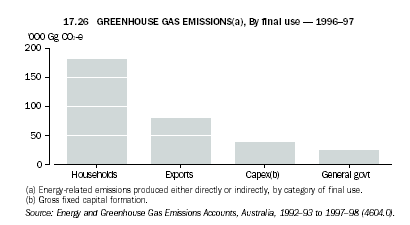|
|
Greenhouse gas emission
Fossil fuel combustion is the major contributor to Australia's greenhouse gas emissions. Table 17.25 shows that the electricity supply industry accounts for nearly half of total energy-related emissions, and that emissions in this industry grew by 25% between 1992-93 and 1997-98. Direct emissions by households contributed around 13% in 1997-98, with most of these emissions due to motor vehicle use. Other significant direct emitters of greenhouse gases included manufacturing of iron and steel; mining; manufacturing of basic non-ferrous metals and products; air and space transport; and road transport (excluding household motor vehicle use). Combined emissions from this group of industries accounted for nearly 20% of energy-related emissions in 1997-98.
17.25 PRODUCTION OF ENERGY-RELATED GREENHOUSE GASES(a), By industry
|
 | 1992-93 | 1993-94 | 1994-95 | 1995-96 | 1996-97 | 1997-98 | Change from 1992-93 to 1997-98 |
 | Gg CO2-e(b) | Gg CO2-e(b) | Gg CO2-e(b) | Gg CO2-e(b) | Gg CO2-e(b) | Gg CO2-e(b) | % |
|
| Agriculture; hunting and trapping; forestry and fishing | 6,053 | 6,252 | 6,518 | 6,737 | 6,988 | 7,188 | 18.8 |
| Mining | 10,986 | 11,237 | 12,295 | 13,271 | 14,596 | 15,136 | 37.8 |
| Manufacturing | 52,431 | 52,934 | 55,665 | 56,603 | 55,437 | 57,166 | 9.0 |
| Electricity and gas | 135,987 | 137,164 | 142,412 | 148,256 | 153,611 | 169,562 | 24.7 |
| Construction | 4,293 | 4,419 | 4,582 | 4,809 | 4,819 | 4,958 | 15.5 |
| Transport | 25,443 | 26,332 | 29,111 | 30,708 | 31,415 | 30,939 | 21.6 |
| Services | 7,781 | 7,997 | 8,325 | 8,610 | 8,823 | 9,063 | 16.5 |
| Household production | 42,194 | 42,990 | 44,051 | 44,361 | 45,286 | 45,587 | 8.0 |
| Total | 285,168 | 289,325 | 302,959 | 313,355 | 320,975 | 339,597 | 19.1 |
|
(a) Excludes fugitive emissions.
(b) Gigagrams of carbon dioxide equivalents (CO2-e).
Note: Due to varying classification systems, definitional differences, and various states of revision of data sources, figures will not necessarily reconcile with other data sources. Statistics of greenhouse gas emissions are also available for 1999 from AGO 2000. |
 |  |  |  |  |  |  |  |
| Source: Energy and Greenhouse Gas Emissions Accounts, Australia, 1992-93 to 1997-98 (4604.0). |

|
 Print Page
Print Page